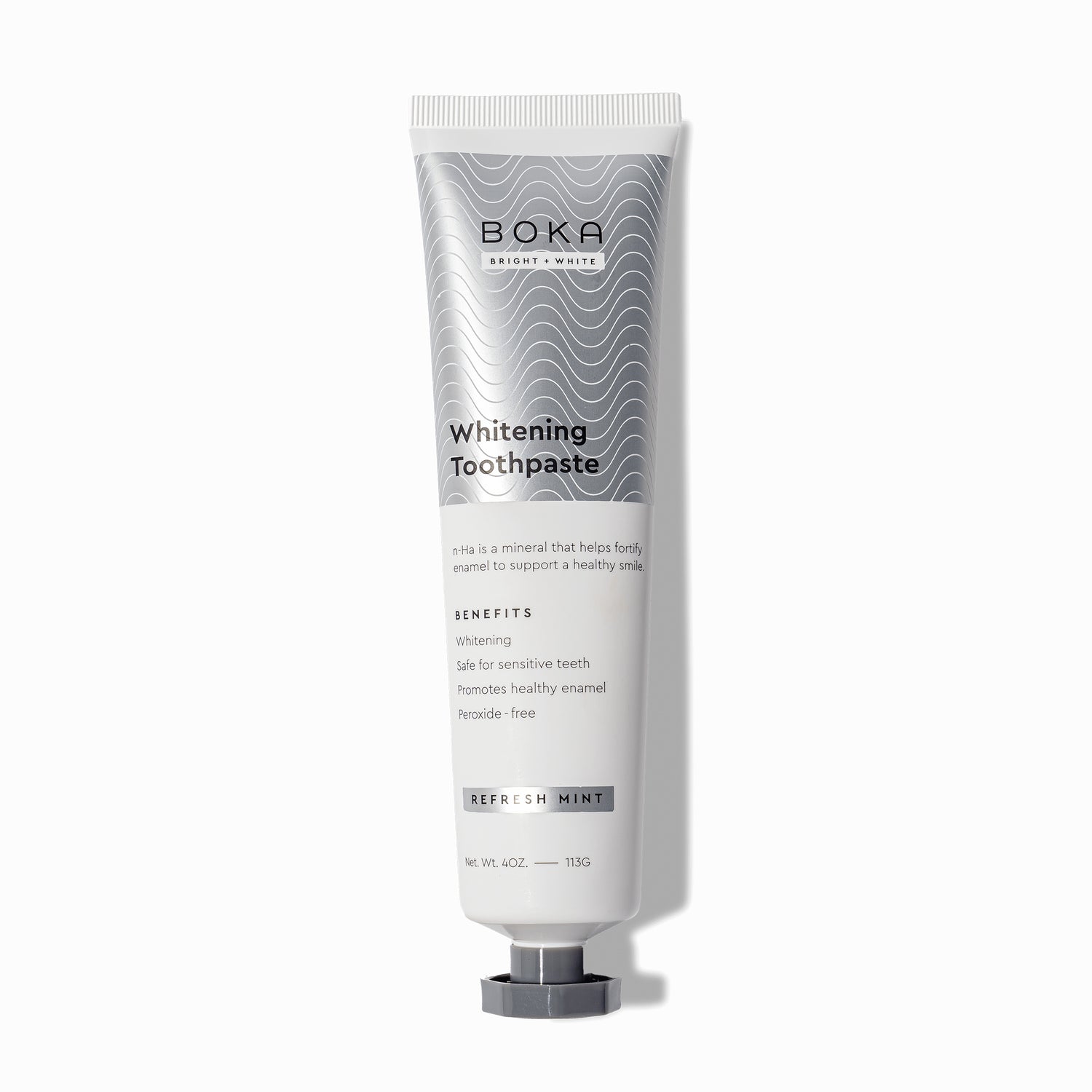Did you know that only around a third of American adults use dental floss every day?
Regularly flossing your teeth keeps them nice and clean, as it helps to remove food particles and plaque that build up between your teeth and gum line.
There are also other health benefits, such as preventing bad breath and reducing the risk of cavities and gingivitis!
However, using dental floss can be a tricky aspect of cleaning your teeth. Sometimes the floss breaks or it doesn't quite fit between each tooth.
That's where dental tape comes in. Like dental floss, dental tape slides between your teeth where your toothbrush otherwise wouldn't reach. But while they sound the same on paper, the two products have a few major differences.
This article will cover:
- The differences between dental tape and dental floss
- Which one comes out on top
- How you can choose the one that's right for you.
So if you're exploring alternatives to dental floss, read on. We'll cover everything you need to know about the two products and how you can use them to keep your teeth sparkling clean!
What Is Dental Floss?
If you don’t already use dental floss, you've likely heard your dentist talk about it.
Dentists love to preach that dental floss is the way you can save your teeth from cavities and plaque and using dental floss in addition to toothbrushing in reducing gingival and plaque indices. But what is it?
Dental floss is a thin thread that you use to clean between your teeth and is typically made out of twisted nylon filaments or plastic monofilaments.
It can come in many forms: you might have seen it in a small container, or attached to a handle as a flossing stick.
Whatever floss you have, you slide it between your teeth a few times to use it. If you're using a long thread, the best way to do this is to wrap it around your fingers. With braces, you'll first need to feed the thread under the wire so it can get between your teeth.
You'll find a lot of different options for dental floss in your pharmacy or supermarket. For example, you can get waxed or unwaxed thread.
There are also a range of eco-friendly dental flosses. Some products use the same thread format but with biodegradable materials like bamboo or silk.
You can even find electric flossers; these use water to pressure-wash your teeth so you don't have to do the hard work of flossing!
What Is Dental Tape?
Like dental floss, dental tape is also a thread you use to clean between your teeth.
The main difference between them is that dental tape is wider and flatter than dental floss. It’s also more stretchy, which makes it ideal for tugging it into tight corners of your teeth.
You use dental tape the same way as dental floss. It slides between your teeth, cleaning off plaque and leftover food.
Its flat surface helps it to rub up against your teeth, and also means it’s less likely to snap against your gums. This makes dental tape ideal for people with sensitive gums.
Dental tape is generally made from waxed nylon threads or polyethylene fiber. You’ll find that there aren’t as many options for dental tape as there are for dental floss as dental tape is already a variation of dental floss (and thus, less common).
Which Is Better: Dental Floss Or Dental Tape?
While both dental tape and dental floss are designed to clean your teeth, there are some stark differences between them. When choosing what one to use, it all comes down to your teeth.
Differences at a glance
|
Dental Floss |
Dental Tape |
|
|
Dental floss
Let’s start by examining dental floss. You might already be more acquainted with dental floss, but here are some key pointers:
It’s thinner, but also weaker
One benefit of dental floss is that the thread is very small and thin. This makes it better for squeezing into tight gaps between your teeth.
However, one downside to this is that dental floss is more likely to break and fray. This is because the friction it creates can break the thread – leaving you with an awkward amount of floss. This means you go through more floss when cleaning your teeth.
It’s easy to maneuver
Another benefit of dental floss is that it’s easy to use and maneuver.
By wrapping it around your fingers, you can leave yourself with as much or as little thread as you’d like. Its small size makes it flexible and easy to get into tight corners of your teeth.
It’s also very thin, which makes it the better option for people who have tight gaps between their teeth. If you have sensitive gums, it can also be a good option that won't irritate.
It comes in lots of variations
Finally, dental floss has lots of different types. While you have the classic thread, you can also find types that are waxed or unwaxed.
The benefit of unwaxed dental floss is that it’s easier to grip with your fingers. However, the downside (and why wax is still an option) is that it's more likely to break and fray.
Dental tape
Now, let’s look at dental tape. While dental tape is already a variation of dental floss, it has plenty of attributes that make it a stand-out competitor:
It’s wider and flatter
The biggest difference is that dental tape is about one millimeter wider than dental floss. It’s also flatter, which is what allows it to slide between your teeth.
This is dental tape's appeal: its large size makes it easier to hold than dental floss.
Dental tape also helps save you a lot of time! The wider-sized thread means you won’t have to rub it back and forth between your teeth as much as you would with dental floss.
It's useful for wider gaps
What makes dental tape stand apart from dental floss is that it's perfect for people with wide gaps between their teeth. While it's wider and flatter, it's also thicker. This makes it easier to slide between teeth as it fits in perfectly.
However, this can be a drawback if you have tight teeth gaps or if you have braces.
Dental tape is much harder to use when your teeth are tightly pressed together, and if you have a wire in front or behind your teeth, it will be more difficult to slide the thread in.
It’s stronger, and less likely to break
Lastly, dental tape is a lot stronger than dental floss. Its wide and thick size means that it won't break as easily during use. This means you won't have to replace the thread that keeps breaking!
Which One Should I Use?
At the end of the day, dental floss and dental tape do the same thing: clean your teeth. When choosing between the two, it’s up to a mix of personal preference and also your teeth size.
If the gaps between your teeth are small and tight, it’s better to go for dental floss. The thinner thread will be easier to maneuver and comfortably slip between your teeth.
If you have bigger gaps between your teeth, dental tape will be the better option. You may find that dental floss will be difficult to use as it's quite thin.
In contrast, dental tape will provide a much smoother experience. As well as this, if you have large hands, then dental tape will be much easier to use than dental floss.
Try Boka's Eco-Friendly Floss For A Healthy Smile And Planet
If you’re environmentally conscious, you may be wondering about the impact dental floss has on the climate. That’s why Boka has designed some eco-friendly flosses that are good for you and the environment!
Boka offers two flavors of normal floss: Ela Mint and Cinna Mint. One is refreshing, and the other is spicy!
Their floss is made using non-toxic ingredients and is Teflon and petroleum-free. Their normal floss only has two ingredients: vegetable wax, and either Ela Mint or Cinna Mint flavoring.
The flosses are free from artificial flavors and plastics. They're also strong, which means you can floss your little heart out.
Features of Boka’s dental floss:
- 30 yards long
- BPA, teflon, parabens, SLS, and PFAS free
- Strong and non-slippery
- Made using vegetable wax.
If you’re looking to make the switch to an electric flosser, Boka offers a new Power Flosser so that you can floss your teeth with the power of water!
The Power Flosser could be the perfect alternative to your dental floss woes. If you’re looking for an eco-friendly alternative that does the work for you, check it out!
Features of Boka’s Power Flosser:
- 3 pressure settings
- 360-degree rotating nozzle for a deeper clean
- 2-minute timer
- Rechargeable Li-ion battery that lasts up to 30 days.
Check out our range of dental flossing bundles here! We also offer fluoride-free toothpaste powered by n-Ha; feel free to check those out.
Related Reads:
- Floss Before or After Brushing: Here’s What Experts Say
- Is Flossing Necessary? (Here’s What Our Analysis Says)
- Does Flossing Create Gaps in Teeth? (+Tips for You)
- Do You Need to Floss Everyday? (Benefits and Drawback)
- Why Avoid Fluoride in Toothpaste? (5 Reasons & Alternatives)
- 14 Essential Oral Hygiene Tips



